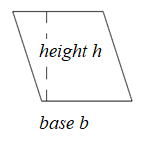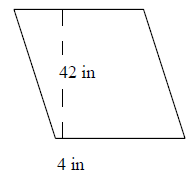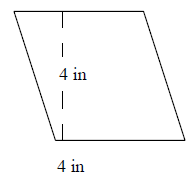
- Perimeter and Area of Polygons
- Home
- Sides of polygons having the same perimeter
- Finding the missing length in a figure
- Perimeter of a piecewise rectangular figure
- Area of a rectangle involving fractions
- Distinguishing between the area and perimeter of a rectangle
- Areas of rectangles with the same perimeter
- Word problem involving the area of a square or a rectangle
- Finding the side length of a rectangle given its perimeter or area
- Area of a piecewise rectangular figure
- Area between two rectangles
- Finding the area of a right triangle on a grid
- Finding the area of a right triangle or its corresponding rectangle
- Area of a triangle
- Finding the area of a trapezoid on a grid by using triangles and rectangles
- Area involving rectangles and triangles
- Area of a parallelogram
- Area of a trapezoid
- Finding the perimeter or area of a rectangle in the coordinate plane
Area of a parallelogram
Introduction

A parallelogram has two pairs of parallel equal opposite sides. It has a base and a height which is the perpendicular distance between the base and its opposite parallel side.
Area of a parallelogram
Area of a parallelogram is found by taking a triangle and relocating it such that parallelogram becomes a rectangle whose area = l × w
Effectively the length l is the base b of the parallelogram and width w is the height h of the parallelogram.
Formula to find area of a parallelogram
Area of parallelogram is = base × height = b × h
Example 1
Find the area of the following parallelogram.

Solution
Step 1:
Area of Parallelogram = b × h; b = base = 4 in; h = height = 42 in.
Step 2:
Area of given parallelogram = 4 × 42 = 168 square in.
Example 2
Find the area of the following parallelogram.

Solution
Step 1:
Area of Parallelogram = b × h; b = base = 4 in; h = height = 4 in.
Step 2:
Area of given parallelogram = 4 × 4 = 16 square in.